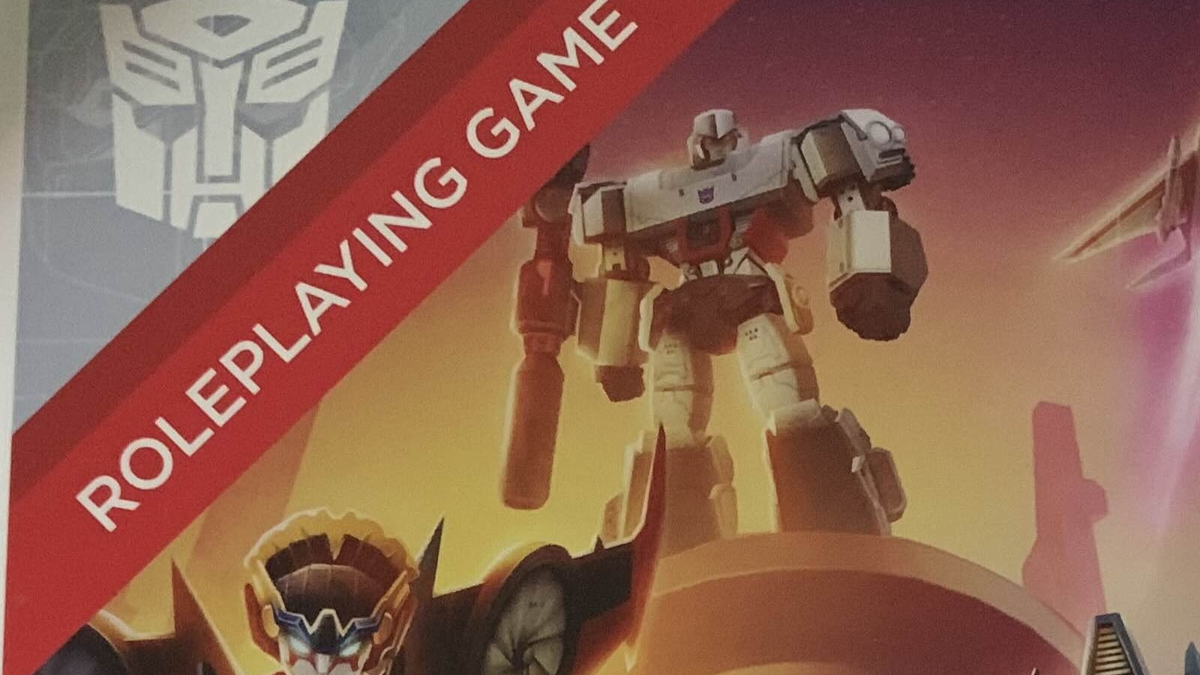
This core rulebook is frankly, gorgeous. The hardcover is in great condition, and the artwork on the inside is superb. But, there are some things that I have major issues with that I can’t ignore. Supplements might fix some of these things, while a re-release of the entire book would be necessary to fix others. Some of the terminology in the book is weird and should’ve been adjusted to fit the property. My major gripe is that I believe this book should’ve been longer and had more character customization inside. Transformers is the perfect candidate for a tabletop roleplaying game, but this does not feel like a Transformers game when you play it. On the bright side, you can strip away all the Transformers branding and create your own brand of Transforming vehicles. Here’s the thing, I don’t hate this game. But it could’ve been so much better.
Game Mechanics

The Transformers Roleplaying Game sees a group of players, typically 3-5, taking on the role of a Transformer. One player will have to be the game master. The game master runs the game, and the other players create characters to play.
This game runs off of the Essence20 system. Your character runs off of Essence. An Essence is your character’s core abilities. You have four Essences:
- Strength: How strong your character is and how much endurance they have.
- Speed: Your agility, balance, and reflexes.
- Smarts: Your awareness, mental acuity, intuition, and analysis.
- Social: Your confidence, poise, charisma, and leadership.
You also get 12 Essence points at the start of character creation. You spend these between the four Essence scores. Each level in an Essence will then give you a Skill Point. In this game, your character is always growing and improving.
Your character also gets Influences. Influences make up the bones of your character. You must select at least one, but I like to run two to keep things interesting. Influences come with a Hang-Up, Background Bonds, and a few Suggested Characteristics. Influences have mechanical benefits. I’ll use the Gladiator Influence as an example here. Gladiators get a Perk that lets you choose an Intimidation Specialization, whether you invested in that Specialization. You’ll gain an Edge on that Skill Test when that Specialization comes into play.
Hang-Ups are a negative effect that comes with an Influence. An Influence is what makes up your character’s background and personality. It’s their experiences before and after coming to Earth. I am addicted to having them on my character sheet because they change how your character plays and add interesting roleplay opportunities. Gladiator has a list of potential Hang-Ups: Impulsive, Vainglorious, and Violent. The way this is formatted makes me want to scream. If you’re coming from the G.I. Joe Roleplaying Game, you might be confused as well! Instead of having the Hang-Ups in detail right on the Influence page, you have to check what they do at the end of the chapter.
The Influence chapter feels barren and devoid of substance. I am reviewing this after G.I. Joe and this whole section is such a massive downgrade in visuals and format that it’s extremely jarring to me. I have a really hard time getting over the amount of negative space in this book.
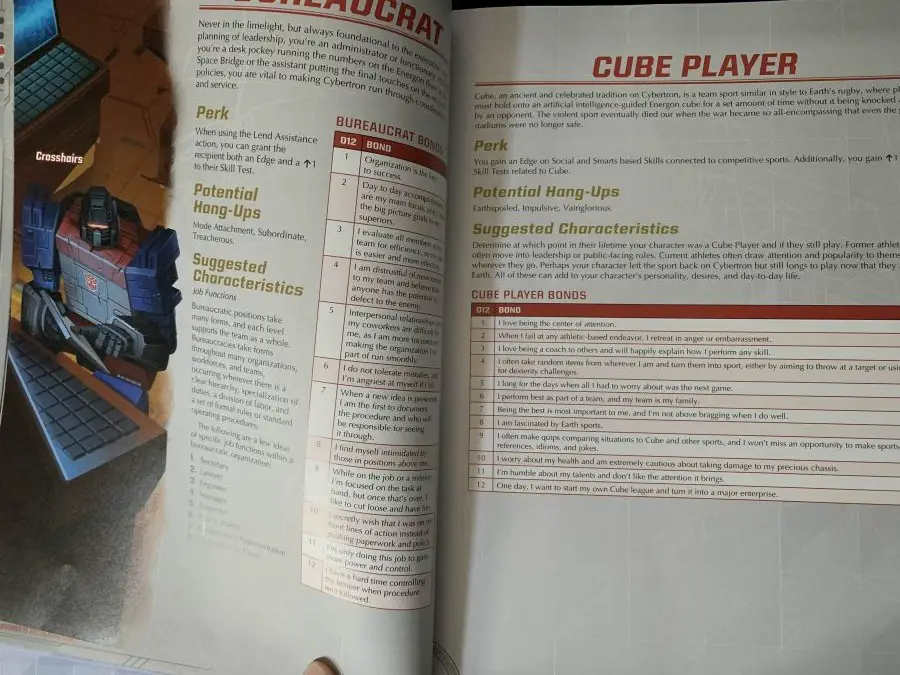
Skills and Abilities
Essence20 is a D20-based system. While playing, you’ll be using several dice ranging from a d2-d20. Now, skills range from a d2 to a d12. You use your base die, which is a d20, and add it to the highest skill die you have. If you don’t have a skill die, you can still attempt the action, but when you do, you’ll get a Snag. Snags require you to roll 2d20 and choose the lowest of the two.
Skills are not static. You’ll be able to increase a Skill’s Rank starting with a d2 and ending with a d12. You’ll also have multiple opportunities to learn new Specializations. Skill Specializations further define what your character is good at.
This book is full of symbols and you must search for what they mean. I wish symbols that appear during character creation were explained in the character creation section. The up and down arrows come up a lot. The up arrow means Edge and the down arrow means Snag. When you roll an Edge, you get a second d20 and pick the higher one you get. A Snag is very similar, instead of rolling a d20 and taking the higher you need to take the lower.
Character Creation
Creating a character in this game does not feel like you’re making a Transformer. I’ll explain more as we go through the character-creation process. The first step is to assign the 12 Essence Points that you start the game with into each Essence Score.
The Influence options are:
- Bureaucrat
- Cube player
- Experiment
- Former Senator
- Gladiator
- Hunter
- Inventor
- Machinist
- Racer
- Scavenger
- Security
- War Veteran
For this character, I’m going to choose Hunter. For my Perk I get to choose a survival Specialization. I picked Tracking because it felt thematically appropriate. Before being able to move on I have to figure out what my Hang-Up does. For some reason, these are listed at the end of the chapter. I picked the Violent Hang-Up: I’m eager for war and seek to be in the center of conflict. Any Skill Test I take during combat that is not explicitly related to said combat takes a Snag.

As a side note, Bureaucrat and Cube Player feel so out of place, they should’ve been left for a sourcebook and replaced with different options. A Cube Player is a character who played Cube on Cybertron.
Now you have to select an Origin. The Origin of your character will define their traits. In this section, you also have to choose your Alt Mode. This section also details how you’re supposed to convert between modes. The Origins in the Core Rulebook are:
- Champion
- Cutter
- Lookout
- Monolith
- Outrider
- Rainmaker
- Seeker
- Support
For this character, I chose to be a Seeker, despite it being more common amongst the Decepticons. I am picking this because my character is a Hunter. The flavor text for Seeker is fantastic too. It talks about how all the nations on Earth carefully monitor their air space. I get to increase my Speed Essence Score by 1. I took an increase in my Acrobatics skill. 3 starting health, and a couple of langues.
At this point, I want to talk about the fillable character sheet. It blows up text to an absurd size and doesn’t always scale it down as you’re typing. The boxes being extended or the text formatting being different would’ve helped in this regard. The flow of the character sheet feels completely off as well. The top portion is alright I suppose, but it would’ve been nice if your ALT mode information wasn’t pushed so far down. I could say the same about the Origin notes too, I don’t understand why they’re at the bottom of the page. Aside from all of that, the sheet is super bland but well-themed.
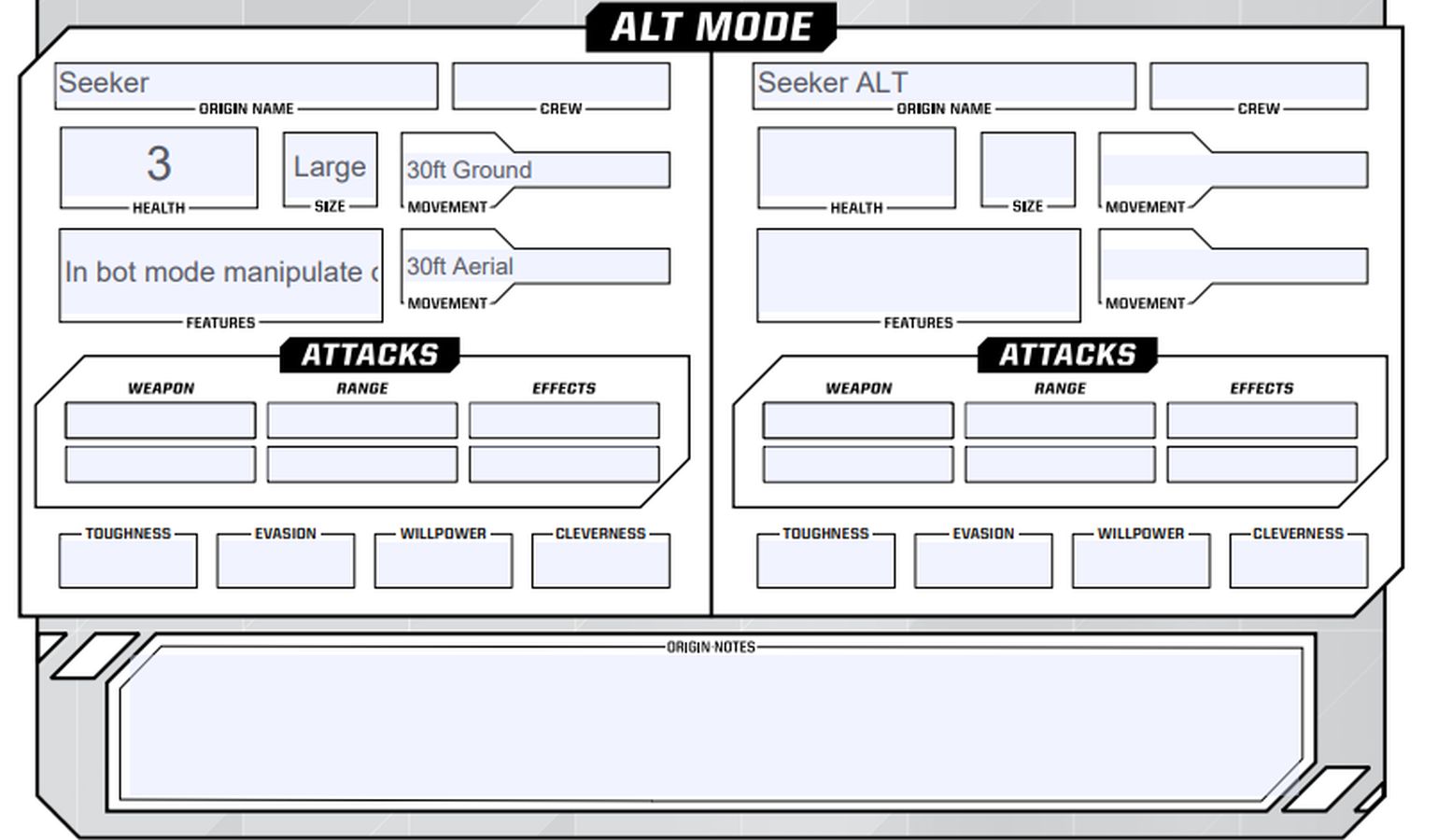
Now you have to select your Role. The Roles in the Core Rulebook are:
- Analyst
- Field Commander
- Gunner
- Modemaster
- Scientist
- Scout
- Warrior
There are also rules for what happens when you lose a limb. I appreciate that because it makes combat feel more impactful and interesting. You can also reattach your limbs, so I think that’s cool. For this character, I’m going to pick Scout for my Role. But the thing is, character creation is not as exciting as it was in G.I. Joe. By the time my players and I got to this point we didn’t want to continue expanding on our characters. There is a serious disconnect between most of the character creation options.
While I understand the Transformers are refugees on Earth and this book plays that up, I would’ve loved more options. Having more to choose from to build out their life before coming to Earth would’ve been awesome. I do appreciate that your character starts with such a little health pool, it makes combat matter more.
One of my biggest issues is how much they mention things that are not in the Core Rulebook. There are a couple of times where combiner Transformers are mentioned, but the rules to making one are in a separate sourcebook. In the future, I hope they cut this out because it can put a damper on character creation.
Layout and Theming
From pages 6-12, you’re introduced to some of the Transformers lore. I am a casual fan of the series, so I did have fun reading this. I am seriously glad that they get this out of the way as soon as possible.
There is a serious issue in this book with artwork cutting through the text. The full-page artwork is gorgeous, and frankly some of the best in any of the Renegade books that I have read thus far but you’ll notice right away that there are a lot of empty pages. This makes the book come off as bland.
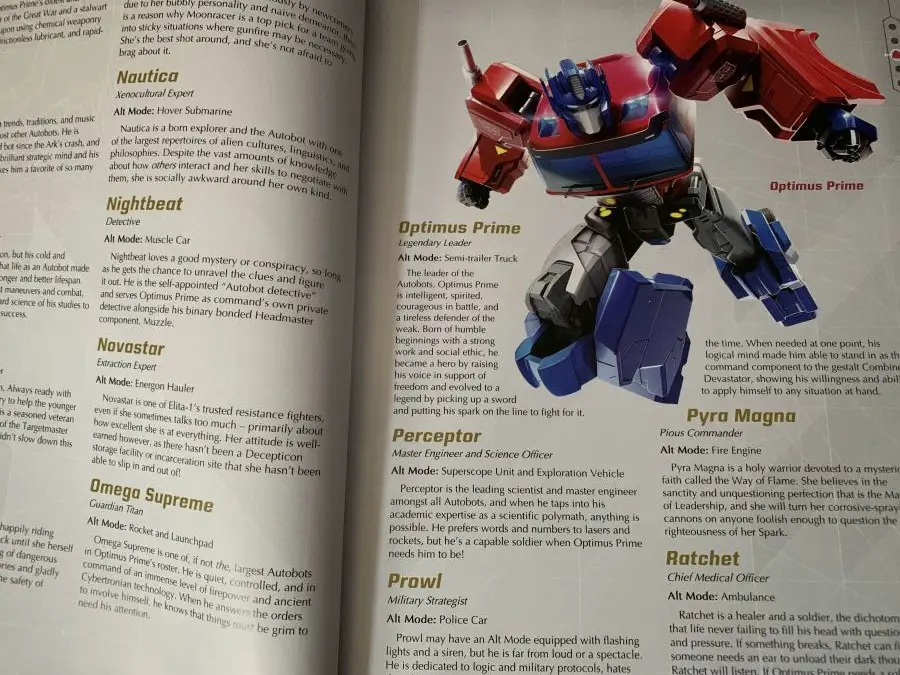
One of my biggest issues with this book is the equipment section. There are no charts, everything is listed out, that would be fine but the flow is completely off. During character creation, we discovered that constantly flipping back and forth became a pain. I’m not sure why they didn’t decide to use tables, but I think it was a mistake to skip them.
There are also no rules for being in disguise. I thought that we would get a couple of things about having to hide from the humans, especially since the role of Scout says that it’s challenging to be an aircraft because of how airspace is monitored. But there’s nothing.
A couple of character creation things feel off base too. I already talked about Cube Player and Bureaucrat, but for some reason, Transformers still get skills like Animal Handling and Performance. I ended up using Performance to make my players feel like they had to hide from the people. These skills are just two examples, but at the end of the day, the character creation feels like it’s supposed to be a rushed 5e hack: a feeling I did not have with G.I. Joe or My Little Pony. The whole book feels rushed, and that’s a total bummer.
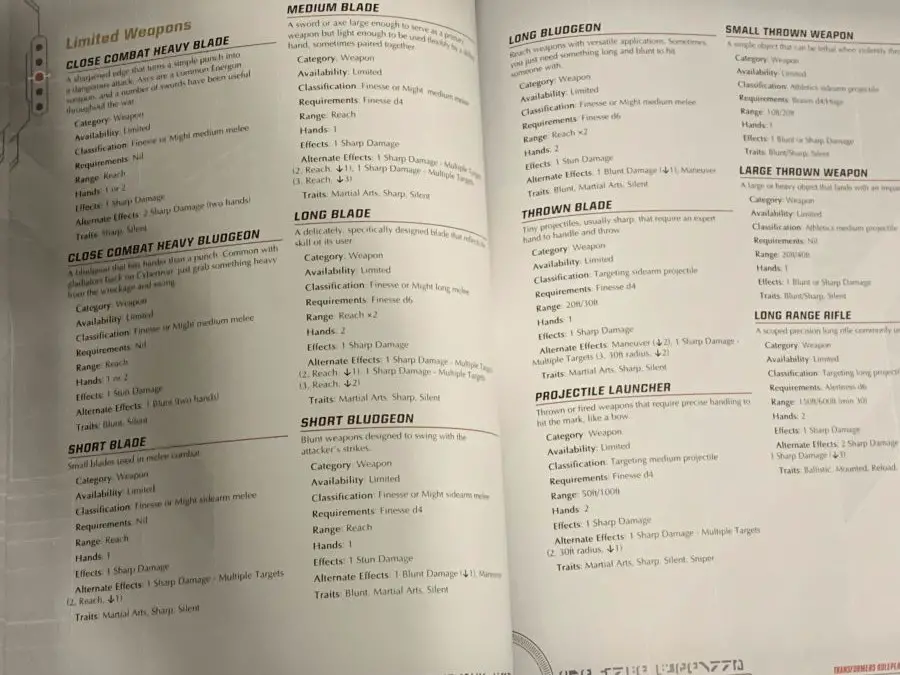
Final Thoughts
The combat rules feel fine, but there’s not much to say about them. They didn’t wow me and didn’t bore me. Combat is fun and feels fluid to run, and they did provide plenty of enemies in the back of the book to use in your adventures. I especially appreciate that human enemies are included in the back of the book. There is a short sample adventure in the back of the book that I used to test the game and we liked it. It’s a great introduction to this game as a whole.
We found the Transformers Roleplaying Game Core Rulebook to be boring. None of us wanted to dive into the finer mechanics because of how character creation went. Running into hints about what could come in supplements was irritating. It feels like the designers couldn’t decide if they wanted this game to be crunchy or not. But here’s the thing, there are still many things to like about this game.
Combat is easy to follow, and it is fun to run combat encounters. My players also enjoyed adventuring once they completed their character creation. Since I have experience running this system, I was able to flavor quite a bit. None of us are hardcore Transformers fans either, so I think that added a little padding to the hard blows we were facing during the game. Once we got through the boring parts, we were having an honest to god good time.
The Essence20 system is not horrible. I like it quite a lot but it feels like they played extremely safe with this Core Rulebook. I think that character creation needed more options and the running a game section needed to be expanded. If you’re going to have an all-in-one game, you can’t leave the game master section to four pages.
Transformers Roleplaying Game
Good
The Transformers Roleplaying Game Core Rulebook leaves a lot to be desired. Parts feel unfinished while other parts feel rushed. It’s not an awful game, but it could’ve been so much better.
Pros
- Fun combat.
- Large selection of enemies.
- Fun starter adventure.
Cons
- Confusing formatting choices.
- Character creation feels limited.
- Four paged game master section.
